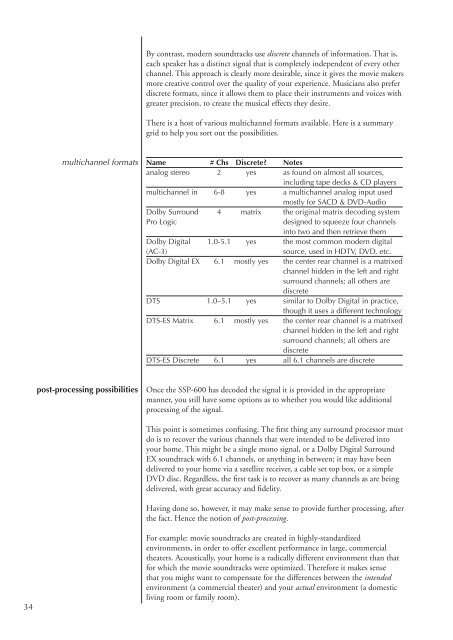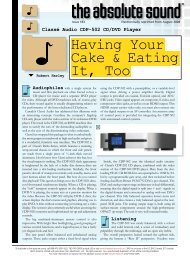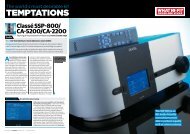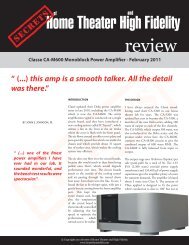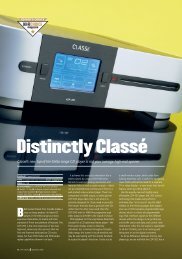Owner's Manual SSP-600 Surround Processor - Classé Audio
Owner's Manual SSP-600 Surround Processor - Classé Audio
Owner's Manual SSP-600 Surround Processor - Classé Audio
Create successful ePaper yourself
Turn your PDF publications into a flip-book with our unique Google optimized e-Paper software.
By contrast, modern soundtracks use discrete channels of information. That is,<br />
each speaker has a distinct signal that is completely independent of every other<br />
channel. This approach is clearly more desirable, since it gives the movie makers<br />
more creative control over the quality of your experience. Musicians also prefer<br />
discrete formats, since it allows them to place their instruments and voices with<br />
greater precision, to create the musical effects they desire.<br />
There is a host of various multichannel formats available. Here is a summary<br />
grid to help you sort out the possibilities.<br />
multichannel formats Name # Chs Discrete? Notes<br />
analog stereo 2 yes as found on almost all sources,<br />
including tape decks & CD players<br />
multichannel in 6-8 yes a multichannel analog input used<br />
mostly for SACD & DVD-<strong>Audio</strong><br />
Dolby <strong>Surround</strong> 4 matrix the original matrix decoding system<br />
Pro Logic<br />
designed to squeeze four channels<br />
into two and then retrieve them<br />
Dolby Digital 1.0-5.1 yes the most common modern digital<br />
(AC-3)<br />
source, used in HDTV, DVD, etc.<br />
Dolby Digital EX 6.1 mostly yes the center rear channel is a matrixed<br />
channel hidden in the left and right<br />
surround channels; all others are<br />
discrete<br />
DTS 1.0–5.1 yes similar to Dolby Digital in practice,<br />
though it uses a different technology<br />
DTS-ES Matrix 6.1 mostly yes the center rear channel is a matrixed<br />
channel hidden in the left and right<br />
surround channels; all others are<br />
discrete<br />
DTS-ES Discrete 6.1 yes all 6.1 channels are discrete<br />
post-processing possibilities<br />
Once the <strong>SSP</strong>-<strong>600</strong> has decoded the signal it is provided in the appropriate<br />
manner, you still have some options as to whether you would like additional<br />
processing of the signal.<br />
This point is sometimes confusing. The first thing any surround processor must<br />
do is to recover the various channels that were intended to be delivered into<br />
your home. This might be a single mono signal, or a Dolby Digital <strong>Surround</strong><br />
EX soundtrack with 6.1 channels, or anything in between; it may have been<br />
delivered to your home via a satellite receiver, a cable set top box, or a simple<br />
DVD disc. Regardless, the first task is to recover as many channels as are being<br />
delivered, with great accuracy and fidelity.<br />
Having done so, however, it may make sense to provide further processing, after<br />
the fact. Hence the notion of post-processing.<br />
34<br />
For example: movie soundtracks are created in highly-standardized<br />
environments, in order to offer excellent performance in large, commercial<br />
theaters. Acoustically, your home is a radically different environment than that<br />
for which the movie soundtracks were optimized. Therefore it makes sense<br />
that you might want to compensate for the differences between the intended<br />
environment (a commercial theater) and your actual environment (a domestic<br />
living room or family room).


